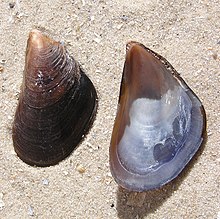Mytilus galloprovincialis
| Mediterranean mussel | |
|---|---|
 |
|
| Two valves of Mytilus galloprovincialis | |
| Scientific classification | |
| Kingdom: | Animalia |
| Phylum: | Mollusca |
| Class: | Bivalvia |
| Subclass: | Pteriomorphia |
| Order: | Mytiloida |
| Family: | Mytilidae |
| Genus: | Mytilus |
| Species: | M. galloprovincialis |
| Binomial name | |
|
Mytilus galloprovincialis Lamarck, 1819 |
|
The Mediterranean mussel (Mytilus galloprovincialis) is a species of bivalve, a marine mollusc in the family Mytilidae. It is an invasive species in many parts of the world, and also an object of aquaculture.
Mytilus galloprovincialis is one of the three principal, closely related species in the Mytilus edulis complex of blue mussels, which collectively are widely distributed on the temperate to subarctic coasts of both the Northern and Southern Hemispheres, and often are dominant inhabitants on hard substrates of the intertidal and nearshore habitats. M. galloprovincialis will often hybridize with its sister taxa, the closely related Mytilus edulis and Mytilus trossulus, when they are found in the same locality. M. galloprovincialis is considered the most warm-water-tolerant species of the three, and has the most southerly distribution in Europe and North America.
In Europe, Mytilus galloprovincialis is found in the Mediterranean Sea and the Black Sea, and on the Atlantic coasts, in Portugal, north to France and the British Isles and Norway. Recently this species has also been found in the European Arctic including northern Norway and Svalbard
In the northern Pacific the species is found along the coast of California, where it was introduced from Europe by human activity in the early 20th century, and also in the Puget Sound region of Washington State, where it has been subject to aquaculture. It is also present as an invasive species on the Asian coast throughout Japan, including Ryukyu Islands, as well as in North Korea and around Vladivostok in Russia.
...
Wikipedia
